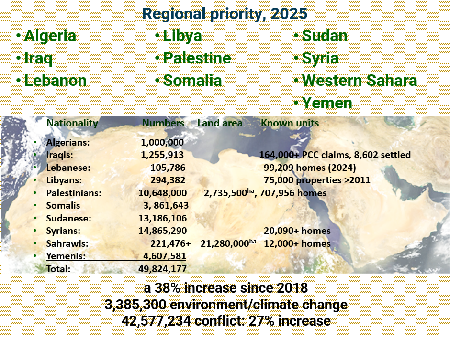A Regional Approach to Remedy Displacement?

The available data from various international organizations generally agree on the estimated numbers of displaced citizens of the countries in the Arab countries. The most regularly updated figures come to us from such practitioner organizations in the displacement field as the UN High Commissioner for Refugees (UNHCR), the UN Relief and Works Agency for Palestine Refugees (UNRWA), the International Organization for Migration (IOM) and the Norwegian Refugee Council (NRC). Their country-specific profiles reflect significant fluctuations in the total of displaced persons at any given time.
With national politics in flux, the numbers of displaced Syrians, Iraqis and Libyans have ebbed and flowed in recent years. The fluctuations in the count of reflect both new internal and external displacements, as well as formerly displaced households returning to their places of origin, although not necessarily to their own homes and lands. Recent wars in Sudan and against occupied Palestine have brought about millions of newly displaced and untold suffering since 2023.
Meanwhile, certain cases remain dormant or stagnant for decades. The numbers of refugees from Israel’s colonial conquests of Palestine in 1948 and 1967 fluctuate mainly due to natural population growth, as do the seldom-updated numbers of refugees from Moroccan-occupied Western Sahara. Other cases linger in—amid official and, hence, popular—amnesia, and their numbers are only rough estimates, as is the case of the Algerian victims of unremedied displacement and dispossession due to civil war in their country in the 1990s. Until their forced eviction and other gross violations are redressed, all the variously displaced Arab people remain eligible for remedy and reparations within the framework of international law.
Despite the commonality of experience, shared culture and language, as well as the often cross-border nature and trajectory of these displacements across the Arab states, no Arab regional approach has emerged on the part of the enumerators or the regional Arab state system. Notably, however, the IOM’s Arab Regional Consultative Process on Migration and Refugee Affairs (ARCP) has met within the rubric of the Global Compact for Safe, Orderly, and Regular Migration to consider displacement broadly to include voluntary migrants with those compelled to leave their homes out of well-founded fear of persecution or due to other imminent danger such as conflict or other human-made causes. None of the ARCP’s 12 current themes, nor the current IOM Arab regional strategy considers remedy and reparations for the eligible millions.
As part of its regular monitoring of housing, land and property (HLP) rights of the Arab peoples across the region, HIC-HLRN began calculating the cumulative numbers of displaced holders of the right to remedy and reparation across the region in 2018, with the 1st Arab Land Conference in Dubai. At that moment, HIC-HLRN reported to that conference that the Arab states’ displaced and refugee population totaled more than 33.4 million persons eligible for housing, land and property (HLP) restitution. In 2022, GLTN/UN Habitat published a rounded estimate of 40 million displaced persons across the Arab region. However, HIC-HLRN updated its detailed tally of eligible HLP rights holders at the 3rd Arab Land Conference (Rabat, February 2025) to over 49.8. million. (See “HIC-HLRN at the Third Arab Land Conference” in this issue of Land Times/أحوال الأرض.)
This upward trend marks 38% more unremedied displacements with HLP restitution rights pending fulfillment. While the 2025 figures also include a newly monitored category of almost 3.4million persons displaced by climate change events and developments, they still reflected a net 42.6 million from conflict, war and occupation. This discrete category of human-induced housing and land rights deprivation shows a net increase of some 27% in the numbers of deprived HLP rights holders over the foregoing seven years.
Meanwhile, the Arab households in the region eligible for HLP restitution—and reparations, more broadly—hovers around the population numbers of a medium-sized country such as Algeria (47,435,312) or Sudan (51,662,147), or ten times the population of Kuwait (5,026,078).
Other regions with greater diversity have managed to mount collective approaches to HLP restitution and the other entitlements of reparation for war-induced displacement. Some have framed their interstate cooperation in regional treaties, as in the model of the Balkan’s Dayton Accords and the Africa’s Pact on Security, Stability, and Development in the Great Lakes Region and its protocols.
Such regional approaches share certain advantages toward durable solutions, because they:
- Are facilitated by shared regional specificity, even with in a common language and culture;
- Could fill gaps and disharmonies in norms prevailing across concerned states;
- Remedy cross-border impacts of conflicts and environmental hazards/climate change;
- Apply local and regional knowledge, whereas local actors are closer to issues;
- Foster interstate cooperation and assistance at a proximity that ensures outcomes reflecting long-term regional interests and development-planning objectives;
- Create a context for mutuality and cooperation toward both national and regional policy formulation; and
- Optimize use of limited resources to maximize impact.
HIC-HLRN will continue to monitor the trends is displacements and the growing numbers of Arab people, and advocate reparation for them all. The volume and nature of the associated HLP and other human rights violations call for such a regional approach that governments seem reticent to assume within their regional arrangements, in the absence of such a vision and purposefully unifying initiative. As with so many other pressing crises, the states and international organizations have left the field wide open for civic initiative, were the Arab region’s civil society so regionally coordinated and disposed to fulfill the need.
Image: Table showing numbers by nationality of persons currently displaced in the Arab region. Source: HIC-HLRN, screen from presentation at the 3rd Arab Land Conference, which the Moroccan host Ministry of National Territory and Urban Planning, Housing and City Policy banned for acknowledging Sahrawi refugees in exile since 1975.
|